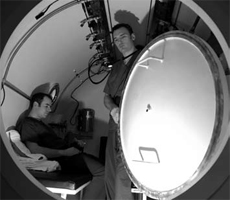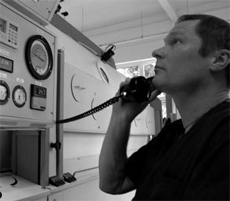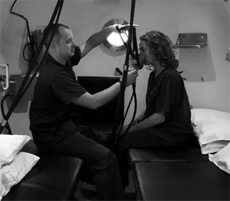




| Home | Features | Club Nights | Underwater Pics | Feedback | Non-Celebrity Diver | Events | 8 August 2025 |
| Blog | Archive | Medical FAQs | Competitions | Travel Offers | The Crew | Contact Us | MDC | LDC |

|

|
 
 |
 |
ISSUE 9 ARCHIVE - AT THE CHAMBERKay RainsleySecrets from the Chamber (not bed)I am sitting in a caravan in St. Abbs. My eleven co-divers have all gone for their morning dive. Over a period of years I have organised many dive trips to St. Abbs – it is one of my favourite sites. As the UK's only voluntary underwater marine reserve it is home to a stunning array of underwater life including the Arctic wolf fish, large crustaceans, octopus and the grey seal. Rocks are resplendent with colour and the ocean floor is carpeted with anemones, brittle stars, urchins, starfish and sunstars. They are probably admiring them and/or photographing them right now. So why am I not with them? |
 |
 |
I've reflected on this. Three weeks ago I
was in the Midlands Diving Chamber.
After an exciting trip to Canada which
included sixteen dives in the Browning
Pass, situated off Vancouver Island;
followed by a rail journey through the
Rockies and further rail travel to Toronto
plus the flight home I still had intermittent
pins and needles in my right hand and
forearm. I returned to work with the usual
post-holiday deluge of e-mails, post and
phone messages waiting. My early
morning swim had re-started the pins
and needles and I swam up and down
hoping that they would go away. They
didn't. The next morning I was forced to
confront the truth – I had 'the bends'.
I telephoned the Midlands Diving Chamber and spoke to Ben Wilson who was helpful, non-judgemental and very understanding. He was very clear in his advice, 'Come to the chamber as soon as you can and we'll be ready for you'. He explained that although I reported pins and needles in my hand and forearm I had, in fact, got bubbles in my brain. I told my rather bemused boss that I had to go to St. Cross Hospital in Rugby for recompression therapy. He told me quite gravely that 'diving was not for him as it was far too dangerous' and promptly went outside for another cigarette. |
 |
 |
The chamber was ready and waiting but
first I had to see the doctor. I gave him
the back story. In Canada I had been
given a twelve litre aluminium tank.
Even with thirty-five pounds of lead I
struggled to get down. I was unwilling
to add extra weight as I was diving on
drop-offs and I didn't want to 'drop off.'
In the UK I wear twenty-two pounds.
Instead my buddy, and husband, pulled
me under the first couple of metres and
I finned down. With nearly a thousand
dives under my weight belt gained over
almost thirty years of diving I figured that
I could cope on surfacing. However I
knew that a couple of times the
emptying tank had caused me to
surface too quickly.
I had dutifully listed my dives, three a day, but hadn't written down the surface interval times which were all respectable. I could no longer put the symptoms down to tiredness, jet lag, or anything else. |
|
|
Dr. Trevor Oxley listened and after
completing various medical tests he
recommended that I receive five hours
and forty minutes of treatment. This was
broken up into intervals of five times
twenty minutes on oxygen punctuated
with five minutes on air followed by thirty
minutes on oxygen during the ascent
from eighteen metres to nine metres
then a fifteen minute air break followed
by sixty minutes on oxygen, fifteen
minutes on air and lastly ninety minutes
on oxygen including the ascent to
ambient pressure.
The choice of outfit for the experience was severely limited to pale or dark blue scrubs which are trousers and a top plus a pair of 'slippers'. Underwear is worn underneath and all jewellery is removed and stored in a locker with personal belongings. Ready to go I stepped into the chamber with Robbie who had the dubious pleasure of sharing the experience with me. Highlights of the dive were Robbie; he was good company and we had ample time to chat about various diving experiences as the fish and chips, drinks and chocolate arrived via the small hatch. Through the larger hatch was a porta-loo which was a change of scenery if nothing else. The downside was that I couldn't wear my glasses with the oxygen mask so I couldn't read but it was a marvellous opportunity to think and relax. There were pillows and a blanket for when the temperature dropped and I was able to put my feet up on the seat opposite. The chamber is quite big (takes ten) so I didn't find it claustrophobic. The following morning I returned for a further treatment of one hour and forty minutes, which flew by. I had had a good night's sleep, the pins and needles had gone and once again Robbie was good company. The experience, whilst it is not one that I would want to repeat, was not unpleasant. Members of staff at the centre are supportive, informative and helpful. I was advised not to dive for twenty-eight days and to return for a diving medical after which I would almost certainly be pronounced fit to dive. I would recommend that anyone who feels that they might have decompression illness ring the chamber for advice. It's free and effective. After all – what have you got to lose – except maybe a few dives in St. Abbs? The London and Midlands Diving Chamber Teams' 24 Hour Advice Line: 07940 353 816. |
 | |
Previous article « Non-Celebrity Diver Next article » Underwater Photography Back to Issue 9 Index | ||